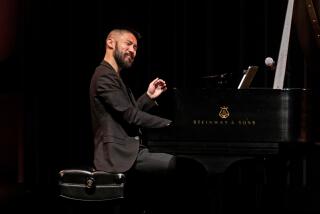MUSIC REVIEW : Leonid Kuzmin in Local Debut Recital
- Share via
With his sassy walk, long curls and up-to-the-minute white-tie-and-tails with baggy pants, Leonid Kuzmin is the very model of a late-1980s pianist. To top it off, he also plays the piano in a most accomplished, semi-serious way.
At his local debut recital, in Segerstrom Hall at the Orange County Performing Arts Center on Tuesday night, the Russian-born, New York-based musician played an old-fashioned but varied program that indicated the possible range of his musical and keyboard interests.
It began with a familiar Mozart sonata and ended with Liszt’s Second Hungarian Rhapsody. In between, there were test-pieces by Chopin and Rachmaninoff.
Not to beat around the bush: Kuzmin’s piano playing is splendid, if sometimes directionless and muddy, and characterized by solid technique and usually tasteful showmanship. At this point in what may be a long career, the young pianist--he turns 24 Saturday--produces musical performances that seem, more often than not, half-baked.
“Gentle brutality,” a phrase used by an East Coast critic, describes Kuzmin’s interpretations of familiar music.
Though he usually makes a round and edgeless tone, and seldom pounds, the tousle-haired pianist can on the one hand sail mindlessly through pages of pianistic poetry with the airiness of a Lazar Berman and, on the other, worry some very uncomplicated musical statements with superfluous and finicky detail.
What he played most impressively on Tuesday--Rachmaninoff’s big-boned Second Sonata, Chopin’s B-flat-minor Scherzo and, as his second encore, Liszt’s transcription of Schubert’s “Soirees de Vienne”--showed a predilection for both size and sensitivity. Here were long lines and comprehensible readings, sure articulation and technical triumph, even a penchant now and again for understatement. Among his other, obvious gifts, Kuzmin clearly possesses genuine talent.
But his playing, as well as his manner, can also become weird, perverse and unconscionable. After a strange spoken introduction to the Second Hungarian Rhapsody--”Yes, everybody deserves some fun!”--Kuzmin brought roaring jollity to the Friska portion, but preceded it with a most unidiomatic and glib reading of the mournful Lassan.
And what he did earlier to Mozart and Chopin (besides the scherzo, the Barcarolle, three Mazurkas and the Nocturne in B), in making sudden tempo-shifts, unmotivated ritards, enigmatic hesitations and even dead stops, threatened to become hair-raising for the wrong reasons.
Remember the name. And hold your breath.
More to Read
The biggest entertainment stories
Get our big stories about Hollywood, film, television, music, arts, culture and more right in your inbox as soon as they publish.
You may occasionally receive promotional content from the Los Angeles Times.










